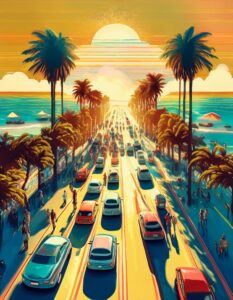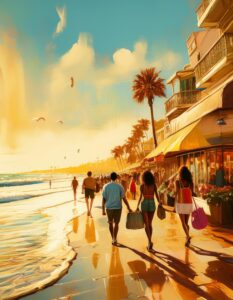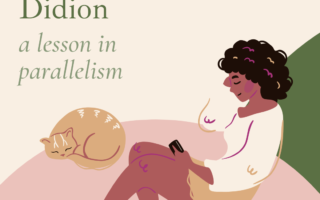Table of Contents
For Spacious Shores

Hermosa Beach
My fingers tap the steering wheel. I am trapped in a trail of cars inching through a Hermosa Beach parking garage. The marquee deceives naive visitors like me, desperate for parking space. It flashes 252 spaces, but none of those are available.
My imaginary camel’s back threatens to break. “Just one more straw,” he says, “And I will collapse. Do you hear me, Ebony?”
I hear him.
 Nearly everyone who enters the garage emerges from its labyrinth twenty minutes later, exasperated. At one point, I was sure I had hit the jackpot. I found an EV parking space in a tight corner.
Nearly everyone who enters the garage emerges from its labyrinth twenty minutes later, exasperated. At one point, I was sure I had hit the jackpot. I found an EV parking space in a tight corner.
I squeezed my car in, hopped out, and noticed the charger looked unusually small. I attempt to fit it into my Hyundai like a toddler trying to fit a square into a circle-shaped hole. Then I noticed the word TESLA branded on its side and felt embarrassed even though no one was interested enough to see my mishap.
Everyone’s gaze ping-pongs between their front window and rearview mirror. The ocean sings her siren song, and we mortals struggle to resist abandoning our vehicles and racing to her shores.
This is Hermosa Beach on a seventy-degree Saturday afternoon in Southern California. Crowds march to the coast, dispersing into clusters of beach blankets, towels, folding chairs, and surfboards. The scene is a perfect backdrop for a Beach Boys song.
But I can’t find parking, not even on the street; cars line curbs, bumper to bumper. My friend finds a cramped space for his motorcycle down the road and jumps in my passenger seat, his thumbs dancing across his iPhone. “Okay,” he says, “Let’s try another lot. Turn right at the light.”
I turn right and drive down a narrow residential street with million-dollar homes and parking restrictions. Young couples on foot hold hands and smile as the ocean breeze blows their hair like a 1980s shampoo commercial. People, young and old, fly by on bicycles. My car trudges with my camel not far behind, his legs trembling.
After three failed attempts to find a parking space, he announces, “I’m done,” before collapsing in the street.
I turn to my friend and say, “I’ve had enough of Hermosa Beach. Let’s go to Manhattan Beach.”
Manhattan Beach
Manhattan Beach is two miles north of Hermosa, but its vibe differs. Hermosa Beach is a wine cooler served in a red plastic cup; Manhattan Beach is organic wine served in a gold chalice.
Within the last ten years, it has gentrified–a lot. Cocoa’s restaurant is now Coffee Bean and Tea Leaf. The Lebanese restaurant Open Sesame is now Urban Plates, which prides itself on “fresh farm salads and chef-crafted sandwiches.”
We find a parking space quickly at Manhattan Beach Village and tour the plaza, in awe of its makeover. Anthropologie, Urban Outfitters, Sunlife Organics, and Coreology Fitness Studios surround an open-air plaza with cushioned seating.
Despite the renovation, Chili’s and the Olive Garden remain untouched. They are the remnants of a humble era lost to a demand for luxury.
My resurrected camel finds me, grieving the loss of Sunday morning pancakes at Cocoa’s. He longs for the days we dined at Island’s Fine Burgers without the temptation to splurge at Mercado.
“But unlike Hermosa Beach, there’s plenty of available parking,” I say, “And you have to admit this place is a yummy piece of eye candy.”
 Unamused, he follows us to the Tin Roof Bistro, where we drink mimosas and eat arugula salad foldover pizza, followed by apple rhubarb crisp with vanilla bean ice cream.
Unamused, he follows us to the Tin Roof Bistro, where we drink mimosas and eat arugula salad foldover pizza, followed by apple rhubarb crisp with vanilla bean ice cream.
I remember visiting the Manhattan Beach shore once as a kid. My mother has repeatedly recounted the following story for me to lose track of where her memory ends and where mine begins.
Early one morning, she took my brother, my younger cousins, and me to the pier when the beach was nearly empty. We ran along the coast, giggling as the chilly water licked our feet.
A middle-aged couple with an unleashed dog strolled ahead of us. When it spotted us playing, it raced in our direction.
My cousins and I froze in fear. My mother said, “Don’t run, or it will chase you!” My eyes widened, and my knees wobbled. The couple ahead of us either didn’t notice or didn’t care that their dog had found unwilling playmates.
My mother yelled, “Excuse me! Can you stop your dog?”
They paused to survey the commotion before calling their dog with as much concern as a tired babysitter.
In my memory, the dog was a ferocious pitbull. When I recently confirmed this with my mother, she laughed: “It was a chihuahua.”
Although I had forgotten the dog’s breed, I hadn’t forgotten my mother’s vexation toward its aloof owners. For her, their lack of regard was personal–a microaggression symbolizing generations of racial tension and inequality along California’s coast. On that day, her camel’s back broke. We never revisited Manhattan Beach’s shoreline.
My friend and I continue our beach crawl north to El Segundo, near LAX airport. Parallel to Vista Del Mar Street, the Chevron Oil Refinery hoards most of the ocean view. Cylindrical metal towers erected from a maze of pipes crisscross into dystopian madness.
Something interesting happens as we continue north: the crowds grow more diverse. Denser pockets of black and brown mingle with white.
El Segundo
At El Segundo Beach and Playa Del Rey border, we come across the Hyperion Water Reclamation Plant–another eyesore along the shore. A hundred years ago, the city of Los Angeles agreed to lease 200 feet of beachfront property near the plant to Titus Alexander, a black entrepreneur. Alexander wanted to build a resort for LA’s growing African-American population, whom the city red-zoned, preventing them from owning property in beach cities, including El Segundo.
When the residents learned of LA’s pending deal with Alexander, they protested, claiming the resort would compromise their safety and the beach’s beauty. The city’s camel crumbled. Los Angeles canceled the agreement.
 We park on a steep residential hillside in Playa Del Rey—spacious homes with slate roofs and grand windows overlooking the ocean loom from the hilltop. Down the slope, clinking glasses and silverware accompany the lively chatter of Salerno Beach Restaurant patrons dining outdoors. A young black waiter with corn-rolled hair balances a wine glasses and pasta tray. An even younger white waitress–a slender brunette–escorts an older black couple to their table.
We park on a steep residential hillside in Playa Del Rey—spacious homes with slate roofs and grand windows overlooking the ocean loom from the hilltop. Down the slope, clinking glasses and silverware accompany the lively chatter of Salerno Beach Restaurant patrons dining outdoors. A young black waiter with corn-rolled hair balances a wine glasses and pasta tray. An even younger white waitress–a slender brunette–escorts an older black couple to their table.
The diverse scene at the restaurant mesmerizes me. It’s beautiful to watch and painful to ponder. One hundred years after the Titus Alexander debacle, black folks still gravitate to this part of the coast–the scraps tainted with oil, waste, and heartbreak. The least sexy strip of land that, one hundred years ago, white folks still clutched because fear clutched them. Sadly, many are still grasping.
We walk to the shoreline and soak in the kinetic energy. Hamburgers sizzle on grills, portable speakers play Drake, and children chase each other in circles. Here, the harmonies of the Beach Boys expand into a bold remix of joy and sorrow–an elegy for dreams deferred and an ode to camels whose broken backs still weep under heaps of straws. Despite its packed parking lot, its open shores promise ample space for everyone.
For more essays like “For Spacious Shores: From Hermosa Beach to El Segundo,” visit ZayZoh.com.


